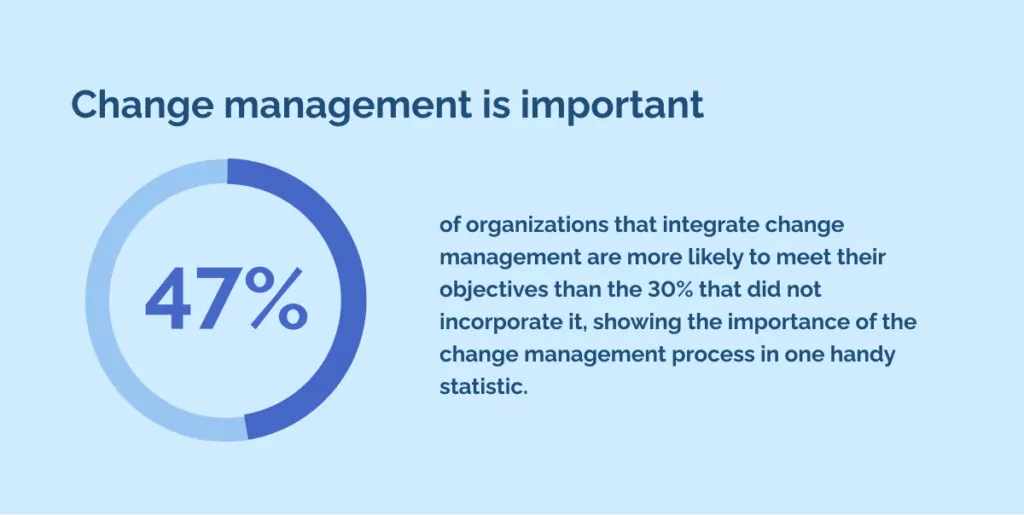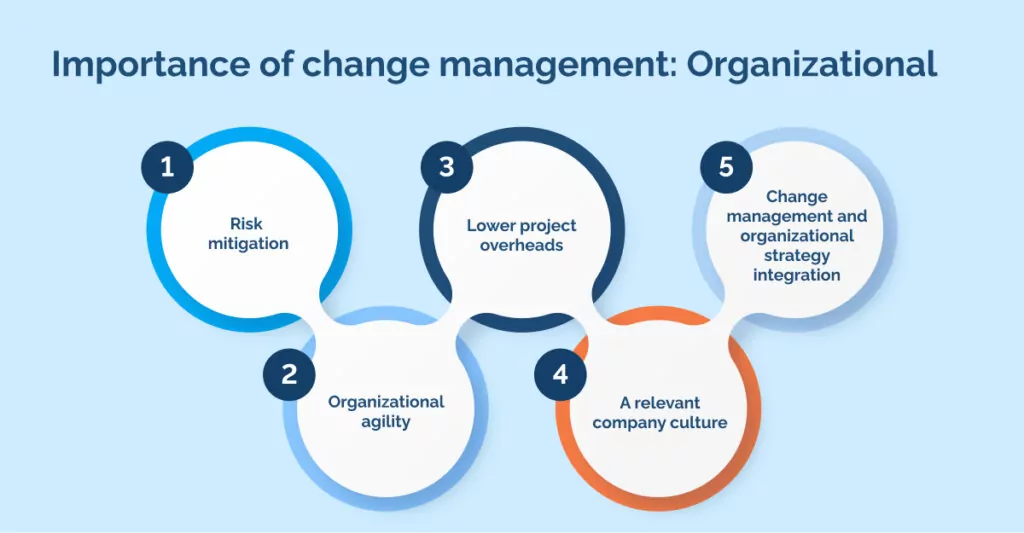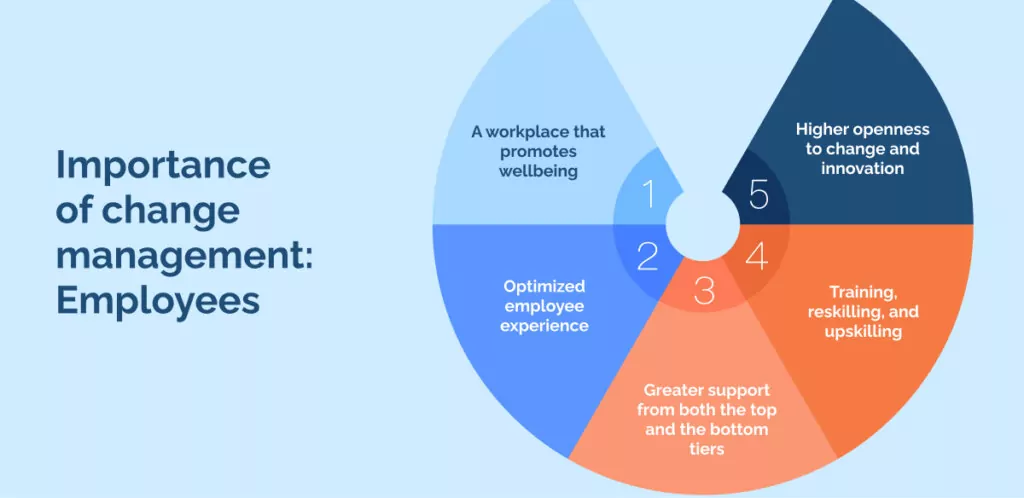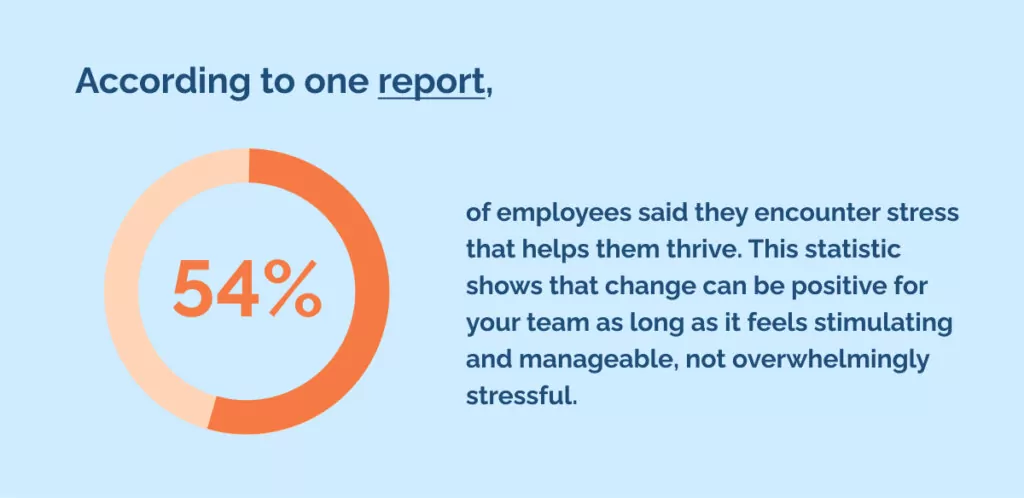
Change management is important, right? But just how important?
The only constant in today’s marketplace is change, which makes change management the most essential tool in your toolbox to ensure your employees are resilient to shifts in the business world.
47% of organizations that integrate change management are more likely to meet their objectives than the 30% that did not incorporate it, showing the importance of the change management process in one handy statistic.

There are ten main reasons for the importance of change management, so in this article, we will explore these ten reasons, split into organizational and employee sections:
Organizational:
- Risk mitigation
- Organizational agility
- Lower project overheads
- A relevant company culture
- Change management and organizational strategy integration
Employee:
- A workplace that promotes wellbeing
- Optimized employee experience
- Greater support from the bottom and the top
- Training, reskilling, and upskilling
- Higher openness to change and innovation
Importance of change management: Organizational

It’s easiest to spot ways change management is important from an organizational perspective. Let’s explore the importance of organizational change management, beginning with risk mitigation within the change process.
1. Risk mitigation
Change comes with risk, which you must mitigate against to ensure you hit goals and achieve ROI as your transformation succeeds, as it leads to the successful implementation of change with new technologies.
A change management plan allows you to identify the necessary people, systems, and processes to effectively execute revised plans and prepare for the risks of any situation.
It is essential to have a robust change management strategy that prioritizes change requests and identifies the most effective solutions to implement those requests with minimal disruption to reduce resource-related risks while managing change.
The role of change managers is to coordinate a change management strategy for how their organization mitigates these risks using the following techniques:
- Risk assessments.
- Predictive modeling.
- Strategic risk mitigation plans.
- Responding to problems as they occur.
As with any other business endeavor, it is essential to make calculated, informed decisions around risk to avoid waste throughout all change management processes.
2. Organizational agility
To stay competitive, organizations must become more agile, changing with transitions in the marketplace by increasing their digital adaptability, responsiveness, and speed to implement organizational change successfully.
This need has driven many organizations to adopt new business models and mindsets to streamline business processes, such as:
- Agile: continuous improvement through small changes to software and uncertainty.
- Lean: continuously improving waste reduction and value delivery of expected outcomes.
- Zero-based mindsets: Reviewing a company’s ambition, choices, and capabilities without being tied to past approaches.
These methodologies help your organization react to external and internal changes proactively and reactively to ensure you remain resilient and sustainable.
3. Lower project overheads
With a change management process in place, it becomes more challenging to handle unpredictable changes. This results in attempting to adjust things as they occur rather than having a prepared plan to address issues.
Last-minute changes to the project increase stress levels, which may result in miscommunication and missed deadlines, adding unnecessary overhead.
Having a change management process helps the team prepare for last-minute changes. The reason is that the process ensures everyone knows how to process unexpected costs.
4. A relevant company culture
Change management helps your company culture to adjust over time and always be relevant to ensure you can attract the best talent and overcome recruitment challenges.
Company culture also has other far-reaching effects on every aspect of a business, including:
- The employee experience.
- Innovation and product development.
- Employee productivity and output.
Even seemingly irrelevant change projects – such as digital adoption and software implementation – can impact company culture.
5. Change management and organizational strategy integration
For organizational strategy to be effective, the company must embrace and integrate change management, which is especially true in the digital age.
After all, disruption, transformation, and change are the norm.
Rather than treating change initiatives as isolated projects, successful companies integrate change into their top-level strategy.
Such strategic integration is paramount for any business that wants to evolve, compete, and thrive in the coming years.
Importance of change management: Employees

1. A workplace that promotes wellbeing
Wellbeing is not just about giving staff what they ask for in terms of comfortable furniture and adequate financial resources to fit their role. It’s also about preparing them for changes and keeping them stimulated in a way they feel is manageable.
According to one report, 54% of employees said they encounter stress that helps them thrive. This statistic shows that change can be positive for your team as long as it feels stimulating and manageable, not overwhelmingly stressful.

2. Optimized employee experience
Employee experience is essential to how your team perceives change management’s importance.
When employees experience a supportive, empowering, and celebratory culture, it leads to a positive experience that fosters a stronger sense of community at work, streamlining and bedding in changes.
When employees feel like they belong or have a meaningful connection with their teams, they produce better quality and well-considered work.
3. Greater support from both the top and the bottom tiers
Change management often leads to more significant support for all tiers of the organization as leaders reimagine hierarchies and the amount of support needed for staff at every level is reviewed and adjusted.
Change projects should align their aims with the entire organization.
Practical change practitioners make it a point to obtain support from:
- Top-level business leaders.
- Middle managers.
- Frontline employees.
- Partners and vendors.
Aligning everyone’s interests helps to increase project outcomes on many fronts – from costs to outcomes.
4. Training, reskilling, and upskilling
Aside from long-term career development, short-term skills, and change management training are also a massive need.
A digital adoption program, for example, involves:
- Software implementation.
- User onboarding.
- Training and education.
By improving change management training, change managers can decrease time-to-competency and learning timelines.
The result is improved engagement, decreased frustration, and improved productivity.
5. Higher openness to change and innovation
Adapting to market or technology changes is crucial for organizational success. In some cases, change becomes necessary, even if it’s just for the sake of change, especially if the current status quo no longer yields positive results.
The agility of organizations allows them to respond promptly and innovatively to market changes and more efficient project management for managers across the organization.
For a company to stay current and ahead in the industry, it’s essential to have both agility and openness. Doing so means quickly embracing new ideas and implementing them to keep up with the changing times.
Use a DAP to show your staff the importance of change management
Change management must be an integral part of the process for organizations to successfully adapt and grow as part of a large-scale organizational change.
You must consider many internal and external factors when developing a sound strategy for large-scale organizational changes.
Taking these into consideration by using a DAP (digital adoption platform) can help communicate the importance of adapting to changes in the corporate environment to your staff as you implement change.
It can also give them the tools for long-lasting transitions using in-app guidance and personalized training.
Change itself is inevitable, and for a company to thrive, it must learn how to manage change effectively for organizational success.
Tristan Ovington
Tristan Ovington is a professional senior writer and journalist, specializing in providing expert insights on various topics such as digital adoption, digital transformation, change management, and Cloud apps. He delivers his knowledge through accessible online content that is data-driven and presented in a friendly tone, making it easy for readers to understand and implement.



